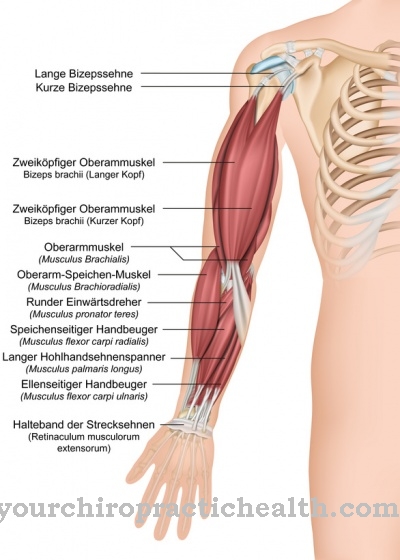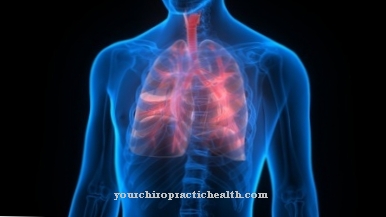Phosphates play a crucial role in the maintenance of many life processes. Phosphate metabolism and calcium metabolism are closely related. Both a phosphate deficiency and an excess of phosphate cause serious health problems that can also lead to death.
What is the phosphate metabolism?

As anions of phosphoric acid, phosphates are involved in all metabolic processes in the body. They are part of the genetic material DNA and RNA, of energy-rich intermediate compounds such as ATP and ADP and, in connection with calcium, of hydroxyapatite, in bones and teeth. In the form of ATP, they play an important role in energy metabolism.
The phosphate metabolism is closely linked to the calcium metabolism. If the phosphate level in the blood rises, the calcium level falls at the same time and vice versa. The main amount of phosphate in the organism is stored in the bones and teeth, around 85 percent. The bones in particular serve as phosphate stores. Approx. 14 percent of the phosphates are located within the cells. There they serve as components of DNA, RNA, the energy carriers ATP and ADP and in the cell membranes as phospholipids.
Phosphates are constantly ingested through food and excreted through the kidneys. An equilibrium is created. Fluctuations in the phosphate level are balanced out by a complex interaction of hormones such as parathyroid hormone, calcitonin and vitamin D, and the excretory function of the kidneys. About 500 to 1000 milligrams of phosphate are absorbed from food every day. The normal plasma level of phosphates is approximately 1.4 to 2.7 meq / l.
Function & task
Phosphates have several important functions in the body. They are involved in building bones and teeth. Furthermore, they link the individual nucleotides of DNA and RNA to form a polymeric genetic molecule. As part of ATP, they serve as energy stores and energy carriers in many chemical reactions in the metabolism. They have become indispensable in both energy and building metabolism.
Many biochemical conversions can only take place through the transfer of phosphate groups. The skeletal system serves as the largest storage of phosphate and calcium in the organism. The bones and teeth are made of hydroxyapatite. Hydroxyapatite is a modified calcium phosphate. When there is an increased need for calcium, the action of parathyroid hormone sets in motion processes that release phosphates and calcium from the bones.
Since the parathyroid hormone mainly provides the body with calcium, it also promotes the excretion of phosphate via the kidneys. Because if the concentration of both calcium and phosphates were to increase at the same time, calcium phosphate would precipitate. That in turn would lower the calcium concentration. In this sense, the phosphate metabolism cannot be separated from the calcium metabolism.
As a rule, the phosphate content in the blood plasma is sufficient to be able to fulfill all functions of the metabolism. If there is a lack of phosphate, the energy metabolism could no longer function effectively. However, since the food contains sufficient phosphates, the phosphate requirement is usually adequately covered.
Illnesses & ailments
The organism is dependent on a functioning phosphate metabolism. Both phosphate concentrations that are too high and too low can lead to serious health problems. If the phosphate level in the blood is too high, it is called hyperphosphatemia. There are both acute and chronic forms of hyperphosphatemia. An acute massive increase in the phosphate concentration leads to serious disturbances that can even be fatal. The phosphates flowing into the blood bind with calcium ions when a certain concentration is exceeded and thus form calcium phosphate. In the short term, dangerous hypocalcemia (insufficient supply of calcium) occurs. This can lead to vomiting, diarrhea, muscle cramps, cardiac arrhythmias, circulatory collapse and sudden cardiac death. In this situation, rapid help in the form of an infusion of a physiological saline solution is necessary to accelerate the excretion of phosphate by the kidneys.
Chronic hyperphosphataemia does not initially cause any symptoms. In the long term, however, the precipitation of calcium phosphate leads to calcification of blood vessels and kidneys. The consequences are, for example, heart attacks or strokes. Hyperphosphatemia can be caused by several causes. The acute form is mainly formed by massive phosphate intake or by extensive necrosis of tissue areas. The decayed tissue releases its entire phosphate supply.
Chronic hyperphosphatemia is often caused by decreased phosphate excretion by the kidneys in renal insufficiency. With an increased activity of the parathyroid hormone, an increased reabsorption of phosphates from the residual urine can also occur.
The same applies to poisoning with vitamin D. In this case, too, the phosphate concentration in the blood is too high. In the long term, the blood vessels become calcified. Therefore, dialysis patients, among others, are threatened by heart attacks and strokes in the long term. In these cases, a low-phosphate diet and the binding of excess phosphates with phosphate binders must be ensured.
In contrast to hyperphosphatemia, hypophosphatemia is rare. This mainly develops with an extremely one-sided diet that is low in phosphate. This mostly affects intensive care patients with low-phosphate artificial nutrition, but also alcoholics. Taking phosphate-binding drugs such as acid blockers can also lead to an insufficient supply of phosphates. Since phosphates are responsible for the energy metabolism, the energy supply of the cells is disrupted. The decrease in the ATP concentration also inhibits the release of oxygen into the blood. In extreme cases this can lead to the destruction of blood and muscle cells.
























.jpg)



